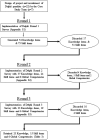Design of a point-of-care ultrasound curriculum for pediatric emergency medicine fellows: A Delphi study
- PMID: 34901685
- PMCID: PMC8637871
- DOI: 10.1002/aet2.10700
Design of a point-of-care ultrasound curriculum for pediatric emergency medicine fellows: A Delphi study
Abstract
Objectives: There has been a steady increase in the growth and utilization of point-of-care ultrasound (POCUS) in pediatric emergency medicine (PEM). POCUS has been established as an Accreditation Council for Graduate Medical Education (ACGME) core requirement for accreditation of PEM fellowship programs. Despite this requirement, training guidelines regarding POCUS knowledge and skills have yet to be developed. The purpose of this project was to develop a curriculum and a competency checklist for PEM fellow POCUS education.
Methods: We formed a core leadership group based on expertise in one or more key areas: PEM, POCUS, curriculum development, or Delphi methods. We recruited 29 PEM POCUS or ultrasound education experts from North America to participate in a three-round electronic Delphi project. The first Delphi round asked experts to generate a list of the core POCUS knowledge and skills that a PEM fellow would need during training to function as an autonomous practitioner. Subsequent rounds prioritized the list of knowledge and skills, and the core leadership group organized knowledge and skills into global competencies and subcompetencies.
Results: The first Delphi round yielded 61 POCUS areas of knowledge and skills considered important for PEM fellow learning. After two subsequent Delphi rounds, the list of POCUS knowledge and skills was narrowed to 38 items that addressed elements of six global competencies. The core leadership group then revised items into subcompetencies and categorized them under global competencies, developing a curriculum that defined the scope (depth of content) and sequence (order of teaching) of these POCUS knowledge and skill items.
Conclusions: This expert, consensus-generated POCUS curriculum provides detailed guidance for PEM fellowships to incorporate POCUS education into their programs. Our curriculum also identifies core ultrasound knowledge and skills needed by PEM fellows to perform the specific POCUS applications recommended in prior publications.
Keywords: curriculum; fellowship; medical education; pediatric emergency medicine; point‐of‐care ultrasound.
© 2021 by the Society for Academic Emergency Medicine.
Conflict of interest statement
The authors have no potential conflicts to disclose.
Figures


References
-
- Moore CL, Copel JA. Point‐of‐care ultrasonography. N Engl J Med. 2011;364:749‐757. - PubMed
-
- American College of Emergency Physicians Emergency Ultrasound Section Writing Committee . ACEP Policy Statement, Ultrasound Guidelines: Emergency, Point‐of‐Care, and Clinical Ultrasound Guidelines in Medicine. American College of Emergency Physicians. June 2001 (revised June 2016). Accessed November 9, 2020. https://www.acep.org/globalassets/sites/acep/media/ultrasound/pointofcar...
-
- ACGME Program Requirements for Graduate Medical Education in Emergency Medicine. Accreditation Council for Graduate Medical Education. 2020. Accessed May 7, 2021. https://www.acgme.org/Portals/0/PFAssets/ProgramRequirements/110_Emergen...
-
- The Emergency Medicine Milestones Project . Accreditation Council for Graduate Medical Education and the American Board of Emergency Medicine. 2015. Accessed April 5, 2020. http://www.acgme.org/Portals/0/PDFs/Milestones/EmergencyMedicineMileston...
-
- Marin JR, Lewiss RE; American Academy of Pediatrics , Committee on Pediatric Emergency Medicine , American College of Emergency Physicians , Pediatric Emergency Medicine Committee . Point‐of‐care ultrasonography by pediatric emergency medicine physicians. Pediatrics. 2015;135(4):e1113‐e1122. - PubMed
LinkOut - more resources
Full Text Sources
Research Materials

